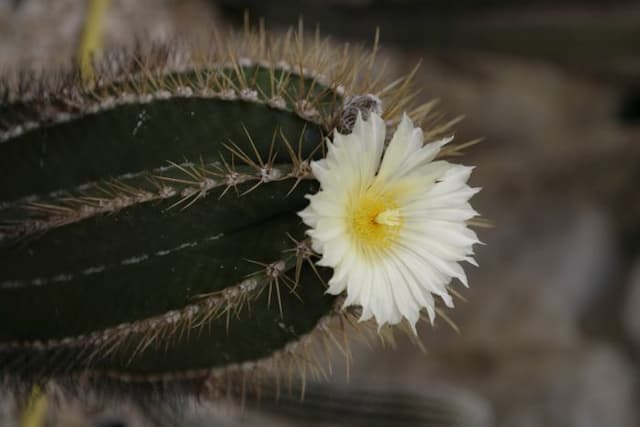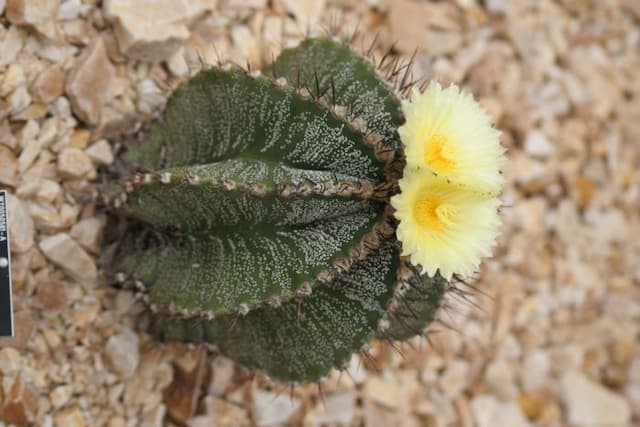Orange matucana Matucana aurantiaca

ABOUT
M. aurantiaca is a cactus forming a cluster of squat, globose stems to 15cm tall, the ribs with red-brown central spines to 4.5cm and shorter radials; orange-red funnel-shaped flowers to 9cm long
About this plant
 Names
NamesSynonyms
Orange Matucana, Orange Cactus
Common names
Borzicactus aurantiacus, Matucana aurantica, Submatucana aurantiaca, Borzicactus aurantiaca, Matucana weberbaueri var. aurantiaca.
 Characteristics
CharacteristicsLife cycle
Perennials
Foliage type
Evergreen
Color of leaves
Green
Flower color
Orange
Height
6 inches (15 cm)
Spread
6 inches (15 cm)
Plant type
Cactus
Hardiness zones
8
Native area
Peru
Benefits
 General Benefits
General Benefits- Ornamental Value: Matucana aurantiaca, commonly known as Orange Matucana, adds aesthetic appeal to a garden or home with its bright orange flowers and attractive green spherical stem.
- Drought Tolerance: This cactus is highly drought-resistant, making it suitable for xeriscaping and low-water gardens.
- Low Maintenance: With its minimal water and care requirements, Orange Matucana is ideal for those who want an easy-to-care-for plant.
- Biodiversity Support: Being a flowering cactus, it can attract pollinators like bees and hummingbirds, thus supporting local biodiversity.
- Long Blooming Period: Orange Matucana flowers for an extended period, which can bring prolonged beauty to an area where it is grown.
- Compact Size: Its small size makes it perfect for growing in containers, on balconies, or in small gardens where space is limited.
- Adaptability: This plant can adapt to a variety of soil types, as long as there is good drainage, making it versatile for different garden settings.
- Educational Interest: As a member of the cactus family, it provides educational value for teaching about plant adaptations in arid environments.
 Medical Properties
Medical PropertiesThis plant is not used for medical purposes.
 Air-purifying Qualities
Air-purifying QualitiesThis plant is not specifically known for air purifying qualities.
 Other Uses
Other Uses- Ornamental Value: Matucana aurantiaca is often cultivated for its aesthetic appeal due to its striking orange flowers and spherical shape, which can add unique visual interest to succulent collections and ornamental gardens.
- Education and Research: This plant may be used in botanical gardens and universities for studying cactus morphology, adaptation, and pollination strategies in arid environments.
- Photography: The bright color and distinctive look of the Matucana aurantiaca makes it an attractive subject for photographers, especially those specializing in botanical and nature photography.
- Hobbyist Propagation: Enthusiasts of cacti often grow Matucana aurantiaca from seeds or cuttings, enjoying the challenge of propagation and the satisfaction of expanding their collection.
- Stress Relief: Caring for plants like Matucana aurantiaca can be a therapeutic hobby that helps individuals relax and destress from their daily routine.
- Green Gifts: Due to its compact size and low maintenance, Matucana aurantiaca makes a suitable and eco-friendly gift option for plant lovers or even as a corporate gift.
- Feng Shui: Some people believe in using Matucana aurantiaca to enhance the energy of a space according to the principles of Feng Shui, attributing to it the power to bring cheerfulness with its vibrant blooms.
- Minuscule Habitats: They can create micro-habitats for tiny insects, providing shelter and micro-climatic conditions within their small spines and crevices.
- Crafts and Modeling: Dried specimens of Matucana aurantiaca or their images can be used in arts and crafts to make botanical models, illustrations, or decorations for thematic displays.
- Space-saving Gardening: Ideal for small spaces, windowsills, or urban balconies, Matucana aurantiaca suits modern living where garden space may be restricted.
Interesting Facts
 Feng Shui
Feng ShuiThe Matucana cactus is not used in Feng Shui practice.
 Zodiac Sign Compitability
Zodiac Sign CompitabilityThe Matucana cactus is not used in astrology practice.
 Plant Symbolism
Plant Symbolism- Resilience: Matucana aurantiaca, commonly known as Orange Torch Cactus, often grows in harsh, arid environments, symbolizing the ability to thrive in challenging conditions.
- Beauty and Vibrancy: The bright orange flowers of the Orange Torch Cactus represent beauty and vibrancy, adding a splash of color to its surroundings.
- Uniqueness: As a less common species of cactus, the Orange Torch Cactus represents uniqueness and standing out from the crowd.
- Adaptability: This cactus's ability to adapt to its environment is symbolic of flexibility and change.
- Protection: Cacti in general, with their spines, represent protection and self-defense, reminding us to set healthy boundaries.
- Endurance: The Orange Torch Cactus's capacity to store water for long periods is emblematic of endurance and long-lasting strength.
 Water
WaterFor the Orange Cactus, it's essential to water deeply but infrequently, simulating the desert rain showers it is adapted to. During the active growing season in spring and summer, water approximately every two weeks, allowing the soil to completely dry out between waterings. Provide a quarter to half a gallon of water, depending on the size of the pot, ensuring thorough saturation. In the winter, reduce watering to once a month or less, depending on humidity levels in your home. It's crucial not to let the plant sit in standing water to prevent root rot.
 Light
LightThe Orange Cactus thrives in bright, direct light, making a sunny windowsill an ideal location. Ensure it receives several hours of sunlight each day, but be cautious of intense midday sun during the hottest months, which might scorch the plant. A spot with morning sunlight and some afternoon shade, or using a sheer curtain to diffuse strong sun rays, can provide the best lighting conditions.
 Temperature
TemperatureThe Orange Cactus can tolerate a range of temperatures but prefers between 50 and 80 degrees Fahrenheit. Protect it from frost, as temperatures below 40 degrees can be detrimental to the plant. Ideal temperature conditions include warm days and cooler nights, which mimic its natural high-desert environment.
 Pruning
PruningPruning the Orange Cactus isn't typically necessary as it's a slow grower and maintains its shape well. However, if pruning is required to remove damaged spines or to shape the plant, it's best done in the spring using sterile, sharp tools. It's infrequent that this cactus needs pruning, so doing so every few years should suffice.
 Cleaning
CleaningAs needed
 Soil
SoilThe best soil mix for the Orange Matucana cactus is a well-draining cactus or succulent mix with added pumice or perlite to increase drainage. Aim for a soil pH between 6.0 and 7.5.
 Repotting
RepottingOrange Matucana cacti should be repotted every 2-3 years, or when it has outgrown its current pot, to provide it with fresh soil and additional room for growth.
 Humidity & Misting
Humidity & MistingOrange Matucana cacti prefer low humidity conditions, typical of arid environments, and can tolerate indoor household humidity levels well.
 Suitable locations
Suitable locationsIndoor
Place in bright, indirect light with occasional direct sun.
Outdoor
Partial sun, protected from afternoon heat.
Hardiness zone
9-11 USDA
 Life cycle
Life cycleMatucana aurantiaca, also known as Orange Matucana, begins its life cycle as a seed, requiring well-drained soil and a warm, dry environment to germinate. After sprouting, the seedling grows slowly, developing into a small, globular cactus with ribbed bodies that may produce offsets as it matures. The Orange Matucana reaches maturity in several years, at which point it can blossom during the summer with vivid orange-red flowers that attract pollinators. Following pollination, the plant produces fruit that contains seeds, thus enabling the cycle to repeat when these seeds are dispersed. Like many cacti, the Orange Matucana has a long lifespan and can survive for decades under the right conditions, going through periods of growth and dormancy that coincide with the seasons. Care includes ample light exposure, infrequent watering, and winter rest periods at cooler temperatures to ensure successful growth and flowering.
 Propogation
PropogationPropogation time
Spring-Early Summer
The most popular method of propagation for the Matucana aurantiaca, commonly known as the Orange Matucana cactus, is through seed sowing. To propagate by seed, one would typically sow the seeds in late winter to early spring when temperatures are mild. Using a well-draining cactus mix, scatter the tiny seeds on top of the soil and lightly cover them with a fine layer of sand or grit. The container should be kept in a warm place with plenty of indirect sunlight and cover it with a clear plastic to maintain humidity. It is crucial to mist the surface gently if it appears dry, but overwatering should be avoided to prevent rot. Seedlings can take several weeks to months to appear, and once they are large enough, they can be carefully transplanted into individual pots.









